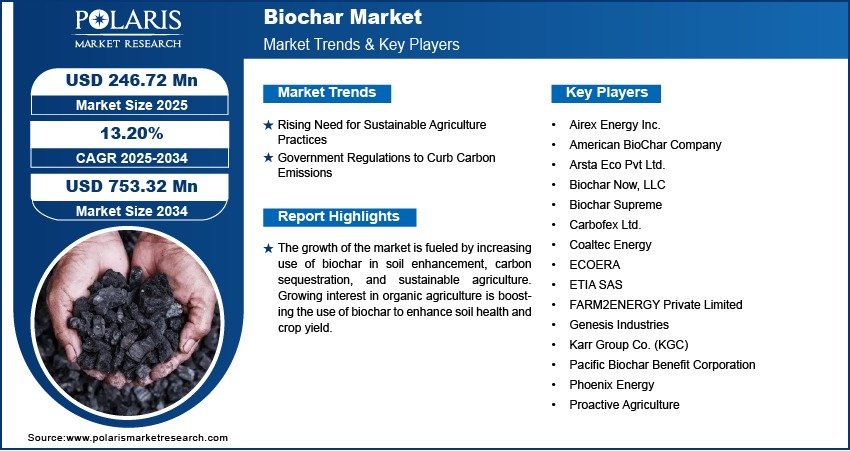Biochar Market Projected to Reach USD 753.32 Million by 2034 | CAGR: 13.20%

The global biochar market was valued at USD 221.79 million in 2024 and is expected to grow at a CAGR of 13.20% from 2025 to 2034. Market growth is driven by the rising adoption of biochar for soil improvement, carbon sequestration, and sustainable agricultural practices.
Biochar Market – Market Trends
- Rising Interest in Carbon Sequestration: Biochar’s role in reducing atmospheric CO₂ is driving adoption in climate-smart agriculture.
- Soil Health & Fertility Boost: Farmers increasingly use biochar to improve soil aeration, water retention, and nutrient efficiency.
- Waste-to-Energy Initiatives: Biochar production from agricultural waste supports circular economy models and renewable energy goals.
- Supportive Government Policies: Incentives and carbon credits in several countries are encouraging biochar production and usage.
Market Size & Forecast
Market Size Value in 2024 USD – 221.79 Million
Market Size Value in 2025 USD – 246.72 Million
Revenue Forecast by 2034 USD – 753.32 Million
CAGR – 13.20% from 2025 to 2034
Request for Free Sample:
https://www.polarismarketresearch.com/industry-analysis/biochar-market/request-for-sample
Industry Overview:
The biochar market is centered around a carbon-rich material produced through the thermal decomposition of organic biomass in low-oxygen conditions, a process known as pyrolysis. Biochar is widely used in agriculture, environmental remediation, and carbon sequestration due to its ability to improve soil fertility, enhance water retention, and reduce greenhouse gas emissions. It serves as a sustainable soil amendment and plays a key role in climate change mitigation strategies by locking carbon into the soil for long periods. The industry includes biomass suppliers, biochar producers, equipment manufacturers, and end-users such as farmers and environmental agencies. With growing awareness of sustainable farming practices and soil degradation issues, the biochar market is gaining traction globally, supported by research initiatives and government incentives promoting circular economy principles.
Key Market Drivers & Barriers:
A major driver of the biochar market is the increasing demand for sustainable agricultural solutions that enhance crop yields while reducing reliance on chemical fertilizers and pesticides. Rising concerns over soil degradation, deforestation, and climate change are also fueling interest in biochar as a viable carbon capture and storage tool. Government funding, carbon credit programs, and supportive policies for renewable energy and waste-to-resource technologies further boost market growth. However, limited awareness among farmers and stakeholders about the benefits of biochar hampers adoption, particularly in developing regions. High production costs, lack of standardized quality regulations, and inconsistent performance across different soil types create additional challenges. Moreover, logistical constraints related to feedstock availability and transportation hinder large-scale commercialization of biochar.
Market Opportunity:
The biochar market presents significant opportunities in expanding its application beyond agriculture into areas such as wastewater treatment, animal feed additives, and construction materials. Growing interest in regenerative agriculture and carbon offset markets opens new revenue streams, especially with the rise of voluntary and compliance-based carbon trading systems. Emerging economies in Asia-Pacific, Africa, and Latin America offer untapped potential due to vast agricultural lands, increasing government support, and rising investments in sustainable development projects. Innovations in pyrolysis technology, feedstock diversification, and integration with renewable energy systems can enhance efficiency and scalability. As sustainability becomes a global priority, the biochar market is well-positioned for robust growth, offering an effective solution for environmental restoration and climate resilience.



![Lubricant AdditivesMarket Analysis: Opportunities, Innovations, and Growth Potential Through [2025-2034]](https://beeswire.com/wp-content/uploads/2025/07/polaris-71-768x768.png)


